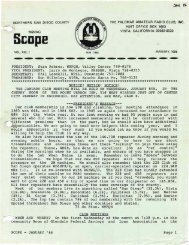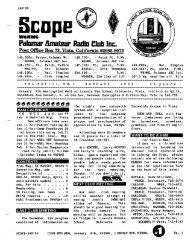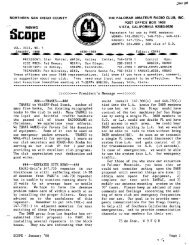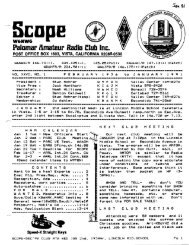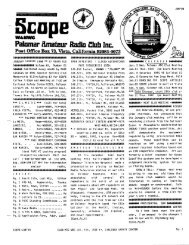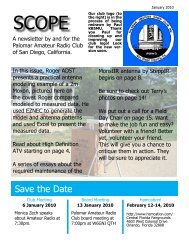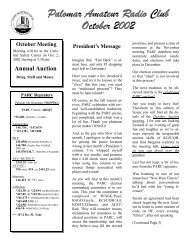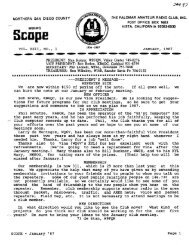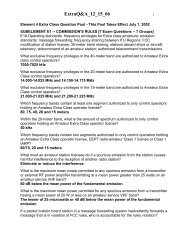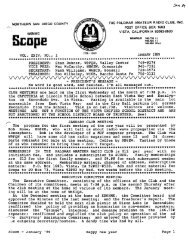You also want an ePaper? Increase the reach of your titles
YUMPU automatically turns print PDFs into web optimized ePapers that Google loves.
Pat is still waiting appointment. What<br />
can the checkers do and not do, well<br />
here is a briefrundown ..... .<br />
~ a. OnJy one checker is required for applications.<br />
b. Deleted entries are not eligible for<br />
card checking (May be sent to ARRL as<br />
a separate application)<br />
c. They may not check 160 meter cards,<br />
they must go to ARRL.<br />
d. They may not check cards over ten<br />
years old, they must go to ARRL.<br />
If it is a first time submission for the<br />
basic DXCC certificate, Harry recommends<br />
bringing about 105 cards to be<br />
checked as no matter how many times<br />
you check them yourselves you may<br />
miss something that disqualifies them.<br />
If you want to make an appointment<br />
with Harry call: 760-743-4212, for Pat<br />
call 619-593-111 L 73, Harry<br />
Propagation<br />
(For those of our members who liki! to<br />
"propagate" here is a copy of the ARLP036<br />
Propagation de K7VVV Ifyou are an ARRL<br />
member, you might wont to sign up for these<br />
bulletins -Ed)<br />
.. .. .. .. <br />
Solar flux and sunspot numbers<br />
were up over the past week. Average<br />
solar flux was up over 17 points and<br />
average sunspot numbers rose over 40<br />
when compared to the previous week.<br />
The peak in activity didn't exactly<br />
coincide for the two indexes, with<br />
sunspot numbers first reaching the peak<br />
at 214 early in the week. If you look at<br />
the graphs at bttp:/Iwww.IWc.cemlsoiar/<br />
you can see the two peaks, and in fact<br />
from this chart it looks like the solar<br />
cycle may have peaked in July.<br />
So when will this solar cycle peak?<br />
NOAA has some new projections. If<br />
you look at bttp:llwww.sec.Doaa.gev/<br />
weeldy/pdflprOJ05.pdf it shows smoothed<br />
sunspot numbers peaking in December,<br />
<strong>2000</strong> at 140. The predicted progression<br />
for smoothed sunspot numbers for August<br />
<strong>2000</strong> through June, 200 I is 136,<br />
137, 138, 139, 140, 139, 138, 139, 138,<br />
137 and 136.<br />
A similar table for smoothed 10.7<br />
cm solar flux shows the predicted peak<br />
around March, 2001 at 189. The predicted<br />
progression for smoothed solar<br />
flux for August <strong>2000</strong> through June,<br />
2001 is 187, 187, 186, 187, 187, 187,<br />
187, 189, 188, 187 and 186.<br />
All this is good news for hams<br />
hoping for a further peak in solar<br />
activity. The best is yet to rome, and<br />
we can look forward to interesting<br />
activity this faD and nel.t spring.<br />
For this week, projections show solar<br />
flux peaking around now and then<br />
dipping down to a short term minimum<br />
around September 21, with the next<br />
peak around October 5.<br />
NW7US wrote this week to tell us<br />
about his web site devoted to radio<br />
propagation. It is at bttp:/llafn- pg.S<br />
·101·<br />
mo.org!propagatiou.html and fea- 1,437<br />
tures a listserver where users can Ott.<br />
be automatically alerted concern~<br />
ing changes in solar and geomagnetic<br />
conditions.<br />
N7S0 wrote to mention other solar<br />
web sites, including solar images at<br />
http://umbra.aasaa.DUll.gevlimagesl.Another<br />
one to check out is http://<br />
www.lpl.arizona.edu/-rIIilllalpo/Mlstufl/recobs.btIDJ<br />
. This has many fine images,<br />
although unless you have a broadband<br />
Internet hookup, the whole page takes a<br />
very long time to load.<br />
Sunspot numbers for August 31<br />
through September 6 were 214, 195,<br />
I 77, 181, 169, 144 and 150 with a mean<br />
of 175.7. 10.7 cm flux was 162.9.<br />
157.7, 154, 154.1, 170.8, 180.2 and<br />
178.7, with a mean of 165.5, and estimated<br />
planetary A indices were 15, 17.<br />
23,9, 14,8 and II with a mean of 13.9.<br />
Identification (more)<br />
Questions have been asked concerning<br />
the station identification procedures<br />
to be followed on PARe repeaters.<br />
To assist you in understanding our<br />
policy, and the foundation from whence<br />
it comes, herewith is an excerpt of FCC<br />
Part 97 rules, taken directly from the<br />
FCC website (www.FCC.gov):<br />
§97.119 Station identification.<br />
(a) Each amateur station, except a space<br />
•<br />
IHAM<br />
• Drop in to see our •<br />
TomKM6K<br />
If CONCEPTS AEA,<br />
display ofworking<br />
RoaN60MW<br />
DIAMOND<br />
OUTBACKER equipment.<br />
JoseXE2SJB<br />
US TOWERS<br />
Lllrsen AntenllS Find out about Pkt<br />
BobKA6EKT<br />
KANTRONICS<br />
location determining<br />
TEN-TEC<br />
equipment (APRS).<br />
YAESU<br />
hy-gllin. Tn-EX,<br />
RADIO Check our complete<br />
MFJ,ICOM cIU"crlljt line ofmagazines.<br />
BENCHER,lne. lind ARRL books, license<br />
HUSTLER others too manuals. and Bulletin<br />
OUTLET<br />
numeroIU to Board with all sorts of<br />
AMEl!.ITRON mention! goodies listed.<br />
~ <br />
COMET<br />
kENWOOD • ~stron, •<br />
dpen: tOa.m. - 5:30p.m.<br />
bireetioas: On 163, take Clairemoat Mesa Blvd. off ramp to East. •<br />
Stay in right-hand lane. Tum right at stop light. As you are turning<br />
Monday tbru Saturday<br />
right you can see our beams in the shopping center. Travel 100 yds. on<br />
858 560-4900 or toU free 1-800-854-6046 Kearny Villa Rd. and U-turn back to shopping area and ORO sign. Be<br />
5375 Kearny ViDa Rd, S. D. sure to see our equipment in action on real antennas .<br />
Adabol/loll1' t<br />
gryat pricell<br />
....



